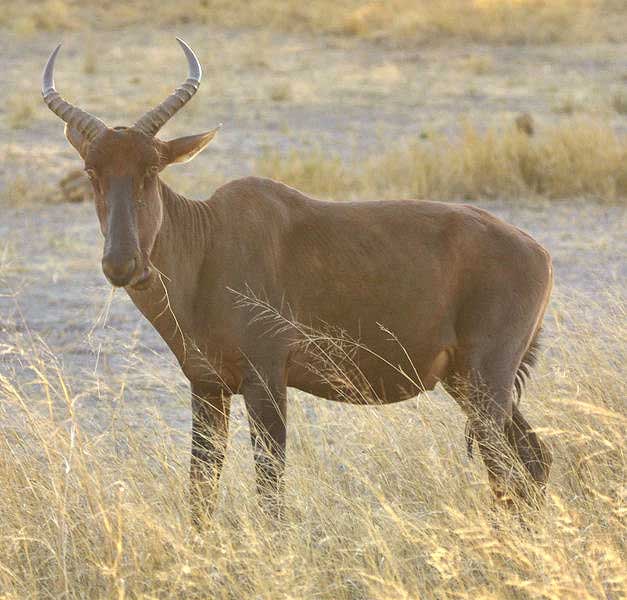Damaliscus lunatus (*) Cladus: Eukaryota Name Damaliscus lunatus (Burchell, 1823) Vernacular names * Sassabi * Tsessebe * References * Damaliscus lunatus on Mammal Species of the World. The Common Tsessebe (Damaliscus lunatus), is a savannah and floodplain antelope found in northern Botswana, eastern Angola, northeastern Namibia, Zambia, Zimbabwe, and parts of South Africa. It is extirpated in Mozambique.[1] Formerly it was included in a species along with the Topi and the Bangweulu Tsessebe, which are today both considered to represent distinct species. Appearance Tsessebe stand over a metre tall at the shoulder and weigh 85 to 165 kilograms. Their coats are a rusty red colour with black legs, chest and a black strip running from forehead to the tip of the nose. The horns are lyre-shaped and are conspicuously ringed and can reach 70 centimetres in both sexes. The horns of older animals tend to wear down, and this can be used as a means of assessing the age of individuals in the field. Ecology and behavior Tsessebe live in savannah and floodplains where they eat mainly grass. Males hold territories from a few tens of thousands of square metres to a few square kilometres. These are marked out with urine, and dung. In the rutting season, some males defend leks, and females preferentially mate the with holder of the central leks; other males, however, continue to hold conventional territories. Females generally live in loose herds of up to twenty females and calves. However, thousands of Tsessebe may migrate together. Males will engage in fights for territory or at the lekking grounds, and these are fought by lunging on to their knees while whacking each other with their horns. Fights between males and females may also be seen. Tsessebe can reach 70 kilometres per hour when frightened and will sometimes jump over each other to get away from a threat. They have the reputation of being the fastest of all antelopes. (The North American pronghorn is faster, having been timed timed at 90 kilometres per hour,[3] but is not an antelope). Research has revealed interesting traits in the sexual behavior of D. Lunatus. Dominant males rebuff the sexual advances of older partners and prefer to mate with new females—this would have the effect of a greater spread of dominant males' genes.[4] Also, males will sometimes make deceptive warning calls about predators when females in estrus appear to be leaving their territory. This usually causes the females to remain nearby, increasing the opportunity for mating.[5] References
Source: Wikipedia, Wikispecies: All text is available under the terms of the GNU Free Documentation License |
|


